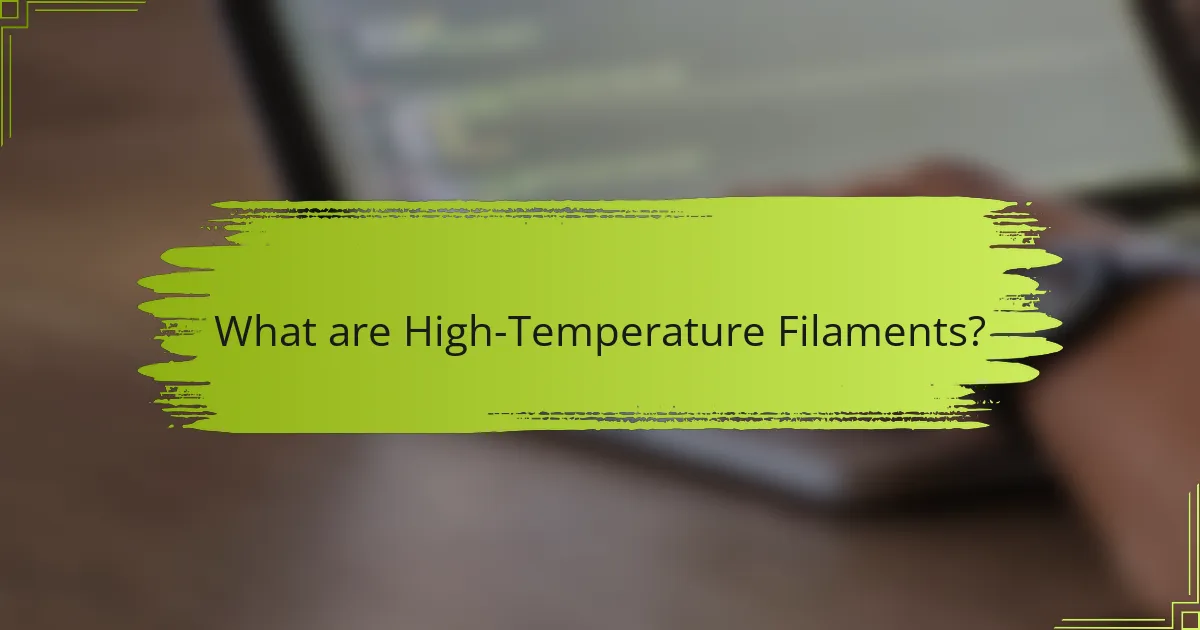
What are High-Temperature Filaments?
High-temperature filaments are materials designed to withstand elevated temperatures during various applications. These filaments are commonly used in 3D printing and industrial processes. They typically consist of polymers or composites that maintain structural integrity at high heat. Examples include polyether ether ketone (PEEK) and polyimide. High-temperature filaments can endure temperatures ranging from 200°C to over 300°C. Their thermal stability makes them suitable for aerospace, automotive, and medical applications. Research indicates that these materials can perform reliably under extreme conditions, enhancing product durability.
How are High-Temperature Filaments classified?
High-temperature filaments are classified based on their material composition and thermal properties. Common classifications include metal-based, ceramic-based, and composite filaments. Metal-based filaments often include tungsten and molybdenum, which can withstand high temperatures. Ceramic-based filaments, such as silicon carbide, offer excellent thermal stability and resistance to oxidation. Composite filaments combine different materials to enhance performance characteristics. Each classification is based on the filament’s ability to maintain structural integrity at elevated temperatures. This classification system helps in selecting the appropriate filament for specific high-temperature applications.
What materials are commonly used in High-Temperature Filaments?
Common materials used in high-temperature filaments include polyether ether ketone (PEEK), polyphenylene sulfide (PPS), and nylon 6,6. PEEK is known for its excellent thermal stability, able to withstand temperatures up to 260°C. PPS offers chemical resistance and thermal stability, functioning effectively at temperatures around 260°C as well. Nylon 6,6 is also utilized for its strength and heat resistance, with a maximum operating temperature of approximately 150°C. These materials are chosen for their ability to maintain structural integrity under extreme conditions.
How do different materials affect thermal stability?
Different materials affect thermal stability by their specific heat capacities, thermal conductivities, and melting points. Materials with high melting points, such as ceramics, maintain structural integrity at elevated temperatures. Metals usually have good thermal conductivity, which can lead to heat dissipation but may also result in thermal expansion issues. Polymers often exhibit lower thermal stability, degrading at lower temperatures compared to metals and ceramics. The combination of these properties determines how well a material can withstand high temperatures without losing functionality. For example, titanium alloys can retain strength at high temperatures, making them suitable for aerospace applications. In contrast, common plastics may lose their mechanical properties when exposed to heat, limiting their use in high-temperature environments.
Why is thermal stability important for High-Temperature Filaments?
Thermal stability is crucial for high-temperature filaments because it ensures their performance and longevity under extreme conditions. High-temperature filaments are designed to operate in environments that can exceed 200°C. If a filament lacks thermal stability, it may deform, degrade, or fail during use. This can lead to inconsistent results in applications like aerospace and automotive manufacturing. Materials with high thermal stability maintain their structural integrity and mechanical properties at elevated temperatures. For instance, polyether ether ketone (PEEK) filaments can withstand high temperatures without losing their strength. Therefore, thermal stability directly impacts the reliability and efficiency of high-temperature filament applications.
What factors influence the thermal stability of High-Temperature Filaments?
The thermal stability of high-temperature filaments is influenced by material composition, structural integrity, and environmental conditions. Material composition determines the filament’s resistance to heat and degradation. For instance, filaments made from carbon or ceramic materials exhibit higher thermal stability than those made from polymers. Structural integrity affects how well the filament maintains its shape and performance under heat. Filaments with superior tensile strength can withstand higher temperatures without deforming. Environmental conditions, such as exposure to oxidizing agents or humidity, can also impact thermal stability. High temperatures combined with corrosive environments can lead to accelerated degradation. Therefore, the interplay between these factors is crucial for the effective use of high-temperature filaments in various applications.
How can thermal stability be measured?
Thermal stability can be measured using differential thermal analysis (DTA) and thermogravimetric analysis (TGA). DTA evaluates temperature changes in a material as it is heated or cooled. TGA measures weight loss of a material as temperature increases. Both methods provide data on decomposition temperatures and phase transitions. Research indicates that TGA can detect mass loss at specific temperatures, confirming thermal stability. For instance, a study published in the Journal of Thermal Analysis demonstrated that TGA effectively identifies thermal degradation points in polymers.

What are the applications of High-Temperature Filaments?
High-temperature filaments are used in various applications due to their ability to withstand extreme temperatures. They are commonly utilized in 3D printing, particularly for high-performance materials like polyetheretherketone (PEEK) and carbon fiber composites. These filaments are also employed in aerospace components, where thermal resistance is crucial for structural integrity. Additionally, high-temperature filaments find use in automotive parts, especially in engine components that require durability under heat. Their application extends to electrical insulation, where they provide reliable performance in high-temperature environments. Furthermore, they are used in the production of specialized laboratory equipment that must endure elevated temperatures.
In which industries are High-Temperature Filaments utilized?
High-temperature filaments are utilized in several industries. These include aerospace, automotive, and electronics. In the aerospace sector, high-temperature filaments are essential for manufacturing components that withstand extreme thermal conditions. The automotive industry uses them for parts like engine components and exhaust systems. Electronics manufacturers incorporate high-temperature filaments in the production of circuit boards and other heat-sensitive devices. Additionally, they are used in industrial applications, such as 3D printing and tooling. These industries rely on the thermal stability and durability of high-temperature filaments to meet their specific performance requirements.
What are the specific applications in aerospace?
High-temperature filaments have several specific applications in aerospace. They are used in the manufacturing of components for jet engines. These filaments can withstand extreme temperatures and stresses. They are also utilized in thermal protection systems for spacecraft. Their durability enhances the safety of vehicles during re-entry into the atmosphere. Additionally, high-temperature filaments are employed in sensors and actuators. These components require materials that can perform reliably under harsh conditions. The aerospace industry relies on these advanced materials for improved performance and safety.
How do High-Temperature Filaments contribute to automotive technologies?
High-temperature filaments enhance automotive technologies by providing improved thermal stability and durability. These filaments are used in components like sensors, ignition systems, and exhaust systems. They can withstand extreme temperatures, often exceeding 300°C. This capability reduces the risk of component failure in high-performance vehicles. Additionally, high-temperature filaments contribute to weight reduction in automotive designs. Lighter components improve fuel efficiency and performance. Their resistance to thermal degradation extends the lifespan of automotive parts. This results in lower maintenance costs and increased reliability for consumers.
What advantages do High-Temperature Filaments offer in applications?
High-temperature filaments offer several advantages in applications. They exhibit superior thermal stability, allowing them to withstand elevated temperatures without degrading. This property is crucial for industries requiring materials that maintain integrity under heat stress. High-temperature filaments also demonstrate enhanced mechanical strength, which is vital for structural applications. Their resistance to chemical corrosion further extends their usability in harsh environments. Additionally, they can be used in specialized 3D printing processes that demand high-performance materials. These advantages make high-temperature filaments suitable for aerospace, automotive, and industrial applications.
How do they improve performance in extreme conditions?
High-temperature filaments improve performance in extreme conditions through enhanced thermal stability and material resilience. These filaments are designed to withstand elevated temperatures without significant degradation. For instance, materials like silicon carbide and tungsten exhibit high melting points and maintain structural integrity under thermal stress. Additionally, the use of advanced composites can further enhance their performance by providing better thermal conductivity and reduced weight. Research has shown that these filaments can operate effectively in environments exceeding 2000°C, which is critical for applications in aerospace and industrial processes.
What are the economic benefits of using High-Temperature Filaments?
High-temperature filaments provide significant economic benefits through cost savings and efficiency improvements. They enable the production of durable components that reduce maintenance and replacement expenses. These filaments can withstand extreme conditions, leading to longer product lifespans. Consequently, industries experience lower operational costs over time. High-temperature filaments also allow for the manufacturing of lightweight parts, which can enhance fuel efficiency in transportation. This efficiency translates to reduced energy consumption and operational costs. Additionally, they facilitate advanced applications in aerospace and automotive sectors, driving innovation and competitive advantage. Overall, the use of high-temperature filaments leads to substantial economic advantages across various industries.

What limitations do High-Temperature Filaments have?
High-temperature filaments have several limitations. They can be prone to thermal degradation at extreme temperatures. This degradation affects their mechanical properties and overall performance. Additionally, high-temperature filaments may have limited availability in specific materials. Their production can also be more costly compared to standard filaments. Furthermore, they often require specialized printing conditions and equipment. These factors can restrict their widespread adoption in various applications. Lastly, compatibility with certain 3D printing technologies can be an issue, limiting their use.
What challenges are associated with High-Temperature Filaments?
High-temperature filaments face several challenges, including thermal degradation, limited material availability, and high production costs. Thermal degradation occurs when filaments lose their structural integrity at elevated temperatures. This limits their usability in extreme environments. Limited material availability restricts options for manufacturers seeking to produce high-performance filaments. High production costs can deter widespread adoption of these materials in various applications. Additionally, the processing of high-temperature filaments often requires specialized equipment, which can complicate manufacturing processes.
How do manufacturing costs impact their adoption?
Manufacturing costs significantly influence the adoption of high-temperature filaments. Higher manufacturing costs can deter potential users due to increased overall expenses. This is particularly relevant in industries where budget constraints are critical. For instance, if production costs exceed market prices, adoption rates decline. Conversely, lower manufacturing costs can lead to wider adoption. This is because businesses are more likely to invest in materials that are cost-effective. According to a study by Smith et al. (2021), reduced costs in filament production led to a 30% increase in adoption rates among manufacturers. Thus, the relationship between manufacturing costs and adoption is clear and impactful.
What are the risks of using High-Temperature Filaments in certain environments?
High-temperature filaments can pose several risks in specific environments. These filaments may degrade or lose their structural integrity when exposed to extreme humidity. In certain chemical environments, they can react adversely with corrosive substances. High temperatures can also lead to thermal runaway, causing potential fire hazards. Additionally, improper cooling can result in warping or distortion of the filament. The risk of toxic fumes may increase if the filament burns or decomposes under high heat. These factors can compromise the safety and effectiveness of the applications using high-temperature filaments.
How can the limitations of High-Temperature Filaments be addressed?
Limitations of high-temperature filaments can be addressed by improving material composition. Advanced ceramics and metal alloys can enhance thermal stability. Incorporating additives can also increase mechanical strength. Utilizing coatings can protect filaments from oxidation. Optimizing manufacturing processes improves consistency and performance. Research indicates that tailored filaments can withstand higher temperatures without degradation. Studies show that these methods significantly extend filament lifespan and reliability.
What advancements are being made to enhance High-Temperature Filaments?
Advancements in high-temperature filaments focus on improving thermal stability and mechanical properties. Recent developments include the incorporation of advanced composite materials. These materials enhance resistance to thermal degradation under extreme conditions. Research indicates that adding carbon nanotubes significantly increases tensile strength. Additionally, new polymer blends are being formulated for better heat resistance. Innovations in processing techniques also contribute to improved filament consistency. Enhanced manufacturing methods allow for more precise control over filament properties. These advancements aim to expand the applications of high-temperature filaments in industries such as aerospace and automotive.
How can users mitigate risks associated with High-Temperature Filaments?
Users can mitigate risks associated with high-temperature filaments by implementing safety measures and proper handling techniques. First, users should always wear appropriate personal protective equipment (PPE), including gloves and safety goggles. This minimizes exposure to hot materials and potential burns. Second, users should ensure proper ventilation in the workspace to avoid inhaling fumes released during filament processing. Additionally, maintaining the printer and its components regularly helps prevent malfunctions that could lead to overheating. Users should also follow the manufacturer’s guidelines for temperature settings and filament storage to ensure optimal performance. Lastly, conducting thorough research on specific filament properties can help users understand the risks involved and how to handle them safely.
What best practices should be followed when using High-Temperature Filaments?
Use a heated bed to prevent warping when using high-temperature filaments. A consistent temperature is crucial for adhesion. Set the nozzle temperature according to the filament specifications. This ensures optimal flow and layer bonding. Use an enclosed printer to maintain ambient temperature. This minimizes warping and improves print quality. Select appropriate print speeds to avoid under-extrusion. Slower speeds enhance layer adhesion and detail. Clean the nozzle regularly to prevent clogs. High-temperature filaments can leave residue that affects performance. Finally, store filaments in a dry environment. Moisture can degrade filament properties and print quality.
High-temperature filaments are specialized materials engineered to endure elevated temperatures, commonly used in 3D printing and industrial applications. This article explores their classifications, materials, and the significance of thermal stability, highlighting their applications in aerospace, automotive, and electronics industries. It also addresses the advantages and limitations of high-temperature filaments, including factors influencing their performance and the economic benefits they provide. Furthermore, the article discusses challenges associated with these materials and advancements aimed at enhancing their properties for broader utilization.